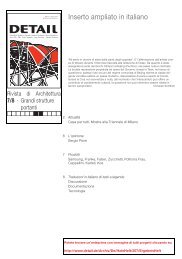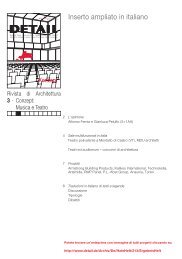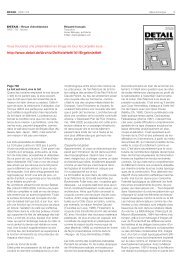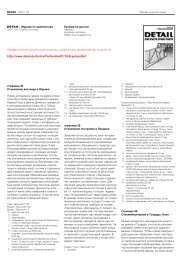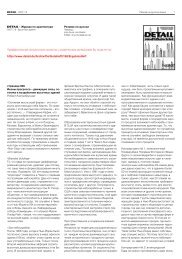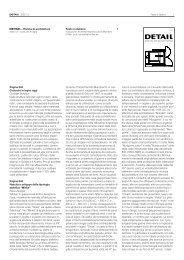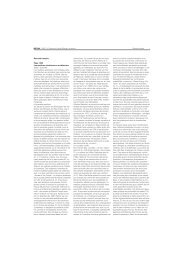Sowjetmoderne Soviet Modernism 1955 â1991 - DETAIL.de
Sowjetmoderne Soviet Modernism 1955 â1991 - DETAIL.de
Sowjetmoderne Soviet Modernism 1955 â1991 - DETAIL.de
You also want an ePaper? Increase the reach of your titles
YUMPU automatically turns print PDFs into web optimized ePapers that Google loves.
SAMSTAG / SATURDAY<br />
24.11.2012, ab / from 17:00<br />
Der letzte Kongress <strong>de</strong>r<br />
ArchitektInnen <strong>de</strong>r UdSSR<br />
The Last Congress of the USSR<br />
Architects<br />
Im Juni 1987 fand in Moskau <strong>de</strong>r 8. Kongress <strong>de</strong>r Architektenvereinigung<br />
<strong>de</strong>r UdSSR statt. So wie alle fünf Jahre versammelte<br />
sich die sowjetische Architekturelite, um einen neuen Vorstand<br />
zu wählen. Trotz <strong>de</strong>r spürbaren Umbruchstimmung <strong>de</strong>utete<br />
nichts auf ein baldiges En<strong>de</strong> dieser mächtigen und einflussreichen<br />
Organisation hin, <strong>de</strong>ren Wirkungsbereich sich auf das<br />
Berufs- wie auch auf das Privatleben ihrer Mitglie<strong>de</strong>r erstreckte.<br />
25 Jahre später versammeln sich in Wien ArchitektInnen <strong>de</strong>r<br />
„<strong>Sowjetmo<strong>de</strong>rne</strong>“, die inzwischen über die ganze Welt verstreut<br />
leben. Als Zeitzeugen berichten sie über ihre Arbeitserfahrungen<br />
in <strong>de</strong>r UdSSR. Initiiert wur<strong>de</strong> die Veranstaltung von Felix<br />
Novikov. Organisatorisch wird sie durch die Architektenvereinigung<br />
Russlands und durch die Internationale Assoziation <strong>de</strong>r<br />
Architektenvereinigungen unterstützt.<br />
-----<br />
The 8th congress of the Union of Architects in the USSR took<br />
place in June 1987. Like every five years the elite of <strong>Soviet</strong><br />
architecture came together to elect a new board. Despite a<br />
tangible sense of imminent change there was nothing to suggest<br />
that this powerful and influential organization, which influenced<br />
both the professional and private lives of its members, would<br />
soon cease to exist. Now, 25 years later, architects of ‘<strong>Soviet</strong><br />
<strong>Mo<strong>de</strong>rnism</strong>’, who today live scattered across the entire world,<br />
are meeting in Vienna. They report, as contemporary witnesses,<br />
about their experiences of working in the USSR. This event was<br />
initiated by Felix Novikov. In organizational terms it has received<br />
support from the Union of Architects of Russia and the<br />
International Association of Unions of Architects.<br />
6 | 19. Wiener Architektur Kongress<br />
SONNTAG / SUNDAY<br />
25.11.2012, 10:00 – 13:00<br />
Lokale Mo<strong>de</strong>rnen. Zentrifugale<br />
Kräfte in <strong>de</strong>r Architektur <strong>de</strong>r UdSSR<br />
Local <strong>Mo<strong>de</strong>rnism</strong>s. Centrifugal<br />
Forces in the Architecture of the<br />
USSR<br />
Entgegen westlicher Vorurteile, die <strong>de</strong>r Architektur aller kommunistischen<br />
Staaten einen gleichförmigen Stil aufgrund einheitlicher<br />
Produktionsbedingungen und Normvorgaben zuordnen wollen,<br />
soll hier auf die große Vielfalt lokaler Strategien, Formen und Maßstäbe<br />
innerhalb <strong>de</strong>r Sowjetunion eingegangen wer<strong>de</strong>n. Während<br />
sich die Baltischen Län<strong>de</strong>r stark an <strong>de</strong>r skandinavischen Architektur<br />
orientierten, kann die Architektur in Weißrussland und <strong>de</strong>r Ukraine<br />
als „proto-sowjetisch“ bezeichnet wer<strong>de</strong>n. In <strong>de</strong>n Republiken<br />
Zentralasiens stellte sich die Frage, inwieweit nationale Wurzeln<br />
und nationale Konstruktionen bedient wer<strong>de</strong>n sollten. Im Kaukasus<br />
erstarkten lokale Architektureliten mit einem autochthonen Stil. Auf<br />
welche Vorbil<strong>de</strong>r, Traditionen und Materialien konnten und wollten<br />
sich die ArchitektInnen in <strong>de</strong>n einzelnen Republiken berufen?<br />
Auf <strong>de</strong>m Prüfstein stehen die Mythen um nationale MeisterarchitektInnen<br />
und Meisterwerke, eigenständige lokale Stile und<br />
subversiven Wi<strong>de</strong>rstand gegen das System.<br />
-----<br />
Contrary to the western prejudice that views the architecture of<br />
all communist states as being essentially similar in style due to<br />
the uniform conditions of production and imposed standards,<br />
here an examination will be ma<strong>de</strong> of the rich diversity of local<br />
strategies, forms and scales within the <strong>Soviet</strong> Union. Whereas<br />
Scandinavian architecture provi<strong>de</strong>d a mo<strong>de</strong>l for the Baltic<br />
countries, architecture in Belarus and Ukraine can be <strong>de</strong>scribed<br />
as ‘proto-soviet’. In the republics of central Asia the extent to<br />
which national roots and national methods of construction<br />
should be used was an important question. In the Caucasus<br />
local architects’ elites emerged with an autochthon style. Which<br />
were the mo<strong>de</strong>ls, traditions and materials that architects in the<br />
individual republics wanted and were able to use? The myths of<br />
national master architects and masterpieces, in<strong>de</strong>pen<strong>de</strong>nt local<br />
styles and subversive resistance to the system are subjected to<br />
scrutiny.<br />
19 th Vienna Architecture Congress | 7



